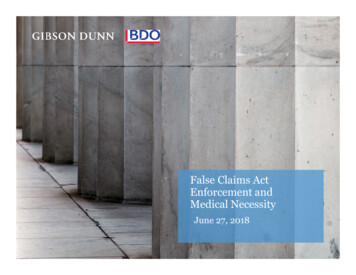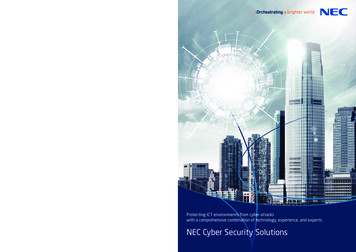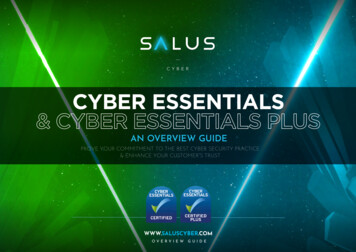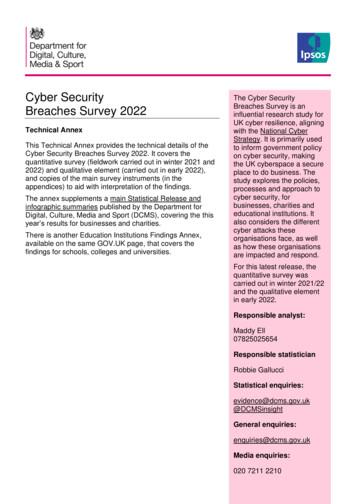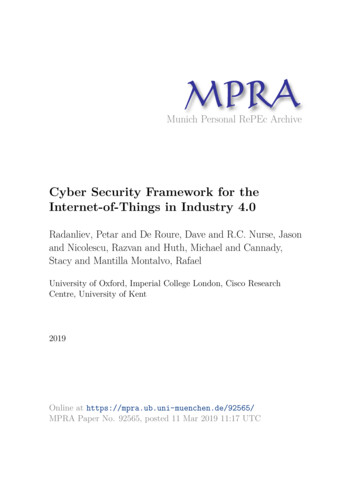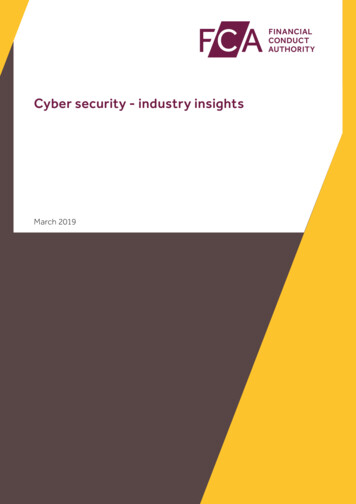
Transcription
Cyber security - industry insightsMarch 2019
SearchFinancial Conduct AuthorityCyber security - industry insightsContents1IntroductionPractices and experiences2Put good governance in place54Protect your assets appropriately8356789How to navigate this documentreturns you to the contents listtakes you to the previous pagetakes you to the next pageprints document23Identify what you need to protect7Use good detection systems10Be ready to respond and recover12Be aware of emerging threats and issuesTest and refine your defencesNext steps111314
SearchFinancial Conduct AuthorityCyber security - industry insights1IntroductionSharing insights on cyber1.1Cyber is complex and unpredictable, and sharing information is vital to successfulcyber defence and resilience. Since 2017, the FCA has brought together over 175 firmsacross different financial sectors to share information and ideas from their cyberexperiences. We run these cyber coordination groups (CCGs) with industry, to helppromote understanding and awareness of innovative cyber practices.1.2The principal objective of the groups is to aid the improvement of cyber securitypractices amongst members of the CCGs and their sectors. We hope the practicesand experience of the groups will benefit other firms, so we are publishing theseinsights to help those firms not already involved.Cyber coordination groups – who they represent1.3The CCGs are sector-specific, and we invited firms to give a representative sampleof the sector, based on cyber maturity. In 2017, the cyber coordination groupsrepresented the following sectors: fund management, investment management,insurance, retail banking, and retail investments and lending. An independentassociation, the Investment Banking Information Security Special Interest Group(IBSIG) has similar objectives. Although it is not co-chaired by the FCA, we have astanding invite.1.4In 2019, we will be creating 2 new groups to increase the representation of tradingvenues and benchmark administrators, and brokers and principal trading firms.Sharing themes to inform the wider industry1.5Since we created the CCGs, we have been actively investigating ways to share theoutcomes and key themes with a much wider financial sector audience. As our2017/2018 cross-sector survey showed, smaller firms assessed themselves as havinggenerally less cyber capability than larger firms. They also showed a higher degree ofvariance in their self-assessments. This indicates a need for a better understandingamongst wider industry of insights and practices.1.6Over the last 12 months, the groups have been discussing and sharing innovativepractices in the following discussion areas: Governance, Identification, Protection,Detection, Situational Awareness, Response and Recovery, and Testing. We havecollated the examples shared by firms and set out those we consider to be beneficialfor a wider audience under each of these themes. These may particularly help smalland medium-sized enterprises.3
SearchFinancial Conduct AuthorityCyber security - industry insights1.74This document should not be considered FCA guidance. It does not set out what ourexpectations are in terms of what systems and controls firms should have in placeto comply with our regulatory requirements. Each of the examples here have beenshared by one or more firms within the CCGs, and many support existing guidancefrom the National Cyber Security Centre (NCSC).
SearchFinancial Conduct AuthorityCyber security - industry insightsPractices and experiences2Put good governance in place2.1Governance enables an organisation to control, direct and communicate theircyber- security risk-management activities. Governing how risks to technologysystems are managed should be no different to the way organisations govern otherbusiness activities. The CCG members agree there is no ‘one size fits all’ approach togovernance. Organisations should establish the security risk-management roles anddecision-making processes that work for them. This supports the NCSC approach tosecurity governance.2.2Firms shared the following practices and insights for governing cyber. They are alignedto business objectives and considered as part of the risk-management framework intheir businesses.A top-down approach Put cyber risk on the executive agenda. Use an enterprise risk managementapproach to articulate and share cyber risk related to business operations,customers and reputation. This will help executives place cyber risk within theappropriate context, and consider it when running their businesses. Educate the executives. Run workshops with executives to increase cyberknowledge. Use case studies and incidents reported in the media to highlightpotential risks and help executives link these risks to their business. Present high-quality management information in useful formats. Presenta simple dashboard to executives that illustrates what is good, what needsimprovement and what is inadequate. The management information helpsarticulate cyber risk in terms of risk that people already understand, such asfinancial losses or brand damage. See the NCSC on this.Make it simple Adopt plain language to articulate cyber. Use language that staff and executivesunderstand and relates to their day-to-day business activities. Recruit champions. Appoint influential members of staff who understand andare interested in cyber to act as a bridge between cyber and the business. Theyalso work the other way, through providing an understanding of the business thattechnology and security functions cannot always see.5
SearchFinancial Conduct AuthorityCyber security - industry insightsThink bigger picture6 Understand who could target your business, why, and how. Understand what datais valuable to which malicious actors. Creating profiles for groups such as hostilenation states, organised criminals, activists, and amateur hackers helps understandtheir goals and capabilities. Ensure there is a link between risk and controls. Controls exist to mitigate risk.Create metrics and indicators for critical controls to understand whether they arefunctioning effectively. Without understanding the effectiveness of controls, it isdifficult to know if risks are being managed. Use existing standards. Standards provide valuable frameworks devised from goodpractice; consider the NIST Cybersecurity Framework, ISO27001/2, SANS CIS,NCSC’s 10 Steps to Cyber Security or NCSC’s NIS Directive Cyber AssessmentFramework, Cyber Essentials, etc.
SearchFinancial Conduct AuthorityCyber security - industry insights3Identify what you need to protect3.1The complexity of organisations and the pace of change makes it difficult to keep trackof your information and systems, and how they are linked and managed. The identifydomain highlights the importance of understanding what it is you are trying to protectand how entities are linked. Without this it is not possible to take a risk-based approachwithin all other domains.3.2Firms shared the following insights and practices:Consider what you already know Use guidance. Use the guidance already available on GDPR Security Outcomesto create and maintain a list of information assets. This includes how businessservices and processes use them. One view is the wrong view. Consider assets from multiple perspectives and drawin data from many sources. This will help build and maintain a complete pictureof the assets you are trying to protect. It might include combining the output ofinformation asset management, system asset management and business services.You should also use change management records, vulnerability scans, anti-virusmanagement consoles and other sources.Understand who you work with Where do you spend your money? Ask the Finance department for a complete listof suppliers. Functioning in an eco-system. Understand the connectivity between anddependency on partners. Adopting the view that you only need to be concernedwith suppliers limits the ability to think wider about third party risk.Have a whole business understanding Business continuity. Use information captured from Business Impact Analysis tobuild a picture of which business services need to be protected and how criticalthey are. Know your business. Stay plugged into new business initiatives so that you canjudge how cyber will need to adapt to the business in the future.7
SearchFinancial Conduct AuthorityCyber security - industry insights4Protect your assets appropriately4.1Tackling external threats requires effective cyber security policies, standards,procedures and controls. These will protect the confidentiality, integrity and availabilityof your business services, while limiting and containing the impact of a potential cyberincident.4.2Firms shared the following insights and practices:Invest in training Continual improvement. One-off cyber security and awareness exercises do notguarantee security. Think long term and design a user education and awarenessprogramme that constantly weaves cyber security into the culture and behavioursof your organisation. Be targeted. Target training the same way a cyber criminal might target specificindividuals, groups of users or a department, such as those with access to criticalsystems. Align training with your employees’ roles, responsibility, duties and accessto data.Manage your third-party suppliers Remember that you cannot transfer the responsibility. Ensure that cyber securityand legal language are added to any contract with the right to audit. Review oldcontracts to ensure that you know your position with third parties.Use encryption Too little or too much. Apply encryption controls proportionately. Not all datarequires every control to be applied. You should apply risk management principlesto determine the impact of data being exposed, based on its classification policy. Only as strong as your weakest link. Define and monitor the policy and proceduralcontrols protecting unauthorised access to your cryptographic keys.Be aware of your vulnerabilities8 Know your weaknesses. Identifying vulnerabilities, weaknesses or flaws that mightbe exploited is a continuous exercise. Any holes in your cyber security could allowmalicious intruders to gain a foothold in your organisation. Know your digital footprint. Cloud and mobile technologies have extended thetraditional on-premise ways of working and delivering resilient business services.You may find your digital footprint is larger than expected.
SearchFinancial Conduct AuthorityCyber security - industry insights Prioritise and fix. It is not uncommon to discover huge quantities of vulnerabilitiesto assess. Knowing the criticality of assets through a Business Impact Analysishelps prioritise which to fix first, and will enable better reporting of yourimprovements. Not all vulnerabilities can be fixed. Some legacy systems or software cannot beupgraded or modified. In this case you can apply and test alternative compensatingcontrols to reduce the risk. No need to re-invent the wheel. Use existing security configuration standardssuch as CIS Benchmarks or NCSC secure configuration guidance as a startingpoint. Once the standards have been formalised they are built into the securityrequirements when designing, modifying or upgrading a business service.Make cyber security part of your change management process Security by design. Include your cyber security team as part of the changemanagement and assurance process. This helps incorporate cyber resilience atthe earliest stage of design, development and system acquisition. It means theywill be there throughout the system development lifecycle and into your changemanagement processes.9
SearchFinancial Conduct AuthorityCyber security - industry insights5Use good detection systems5.1Firms must be able to detect actual or attempted attacks on systems and businessservices. Thorough and effective system monitoring is essential to detection andhelps to ensure that systems are being used in line with organisational policies.5.2Firms shared the following insights and practices:Tackle the insider threat Who’s who. Tie specific users to specific accounts through your identity and accessmanagement processes. This gives you a solid basis for ensuring individuals haveappropriate access rights, and correctly attributing system misuse. Know your privileges. Identify users with privileged access to critical systems, andreview this on a regular basis. Heighten monitoring on these systems and considerusing Data Loss Prevention tools. Monitor behaviour. Use network behaviour monitors and user behaviour analysis toidentify deviations from the expected patterns of activity. Pay particular attentionto users with access to critical systems.Establish an effective monitoring regime10 Use the right information for you. Choose which logs to collect based on yourunique circumstances, and generate alerts that are relevant. Ensure these allowyou to see external network communication, cloud services and third parties todetect Indicators of Compromise. Tamper proof. Prevent cyber criminals removing traces of their actions bysegmenting, monitoring, alerting and applying strong access controls to auditdatabase logs. Validate. Review and assure your log sources are working as intended. Configurealerts when systems stop forwarding logs. Being unable to restore your archivedlogs during an incident will make it harder to recover. Check that your archived logscan be securely restored and are searchable. Synchronisation. Use a resilient authoritative time source across all theorganisation’s systems.
SearchFinancial Conduct AuthorityCyber security - industry insights6Be aware of emerging threats and issues6.1You need to be alert to emerging threats and issues to make informed cyber resiliencedecisions. This intelligence may come from a variety of internal and external sources,which highlights the importance of sharing intelligence when possible.6.2Firms shared the following insights and practices: Participate in forums. Incorporate the sharing of information and intelligence inrecognised information-sharing forums into your incident response plan. Poolingdata and insights means you and your peers are more likely to benefit from theseforums. Feed into planning. Use plausible scenarios or examples from the media tocontinuously improve and refine how information is shared and communicated tointernal and external stakeholders. Learn from others. Use the events that have affected others and assess theimpact against your own firm and defences. Ask yourself if your firm would havebeen protected against that incident? Or would that event even affect your firm?You can learn lessons from both internal and external incidents.11
SearchFinancial Conduct AuthorityCyber security - industry insights7Be ready to respond and recover7.1Incidents will occur. The ability to respond and recover from them should be a keypart of a business’s risk management and operational resilience planning. Resumingcritical business services rapidly and with accurate data requires continuity planningand testing of plausible cyber-attack scenarios. Exercising people, processes andtechnology is a key aspect in preparing response and recovery planning.7.2Firms shared the following insights and practices:Create scenario-led exercises Test plausible scenarios. Plan on the assumption that the inevitable will happen,and test plausible scenarios tailored to your business. Identify your critical services,people, processes and third parties that underpin these services to assess theimpact on your business. Make recovery decisions before an incident happens. Define your businesstolerance for the recovery of individual systems and data using Recovery PointObjectives (RPOs) and Recovery Time Objectives (RTOs) to minimise the need tomake pressurised recovery decisions during an incident. Review these objectivesregularly to ensure they are right for your business. Lessons learnt. Allocate enough time and resources for reviewing informationcaptured during a cyber incident. You can use this to improve your response andrecovery controls. Inception to reporting. Evaluate and exercise your cyber capabilities and businessprocesses by creating and executing plausible threat-driven playbooks. Theseshould focus on assessing the effects on your critical business services.Investigate all incidents7.3Know the basics. The ability to conduct basic investigations is key. Train your teamwith the necessary skills or bring in specialist consultants or third parties. Simulate anincident investigation process end-to-end to familiarise them with the process.Know how to communicate7.4Make it work internally. Establishing and testing internal communication channelswith key decision makers will make key decisions faster and simpler in a crisis. It will alsoensure people know who is accountable for decisions.7.5And externally. Run stakeholder communication practise by creating a multi-channelincident response plan while maintaining a consistent message.12
SearchFinancial Conduct AuthorityCyber security - industry insights8Test and refine your defences8.1Testing the cyber defences of your whole organisation ensures you understand theeffectiveness of controls across people, process and technology. A strong testingregime helps develop a culture for continuous improvement as issues are discoveredand fixed.8.2Firms shared the following insights and practices:Create a comprehensive framework Continual improvement. Review exceptions, non-conformities and perform rootcause analysis of incidents and near-misses to help challenge the effectiveness ofpolicies, standards and procedures. Emulate the threat. Use more than one method to identify and assess yoursecurity vulnerabilities. Considering a variety of proactive methods may providegreater clarity (for example, penetration testing, phishing simulations, vulnerabilityscanning, red/purple teaming). Testing approach. Consider the views of your users and security operations centrewhen deciding what testing approach to take. No assumptions. Do not work on the assumption that controls are operatingeffectively. Use information about your controls and their objectives to create andrun tests to understand if the controls need to be improved or replaced.Invest on testing and training staff Make reporting easy. Implement easy ways for staff to report phishing (such asa button on your email toolbar) and procedures that deal with reported phishingemails. Adopt password testing. Test employees’ passwords across exposed credentialdumps along with commonly used credentials. Continuous development. After identifying areas of weakness and providing stafftraining sessions, reassess these areas to test the effectiveness of the program.13
SearchFinancial Conduct AuthorityCyber security - industry insights9Next steps9.1We encourage all firms to consider whether these insights may be useful to them inconsidering their own cyber resilience. The insights are also shared with the otherfinancial authorities who attend CCG meetings, including the Bank of England and theNCSC. The insights provide a valuable input to help shape NCSC advice and guidance.9.2Sharing information is vitally important to increasing levels of cyber resilience inthe financial industry. Over the next 12 months we will continue to look for ways tocommunicate insights and innovative practices shared within the CCGs with the widerfinancial community.14
Pub ref: 005905 Financial Conduct Authority 201912 Endeavour Square London E20 1JNTelephone: 44 (0)20 7066 1000Website: www.fca.org.ukAll rights reserved
Cyber security - industry insights 1 Introduction Sharing insights on cyber 1.1 Cyber is complex and unpredictable, and sharing information is vital to successful cyber defence and resilience. Since 2017, the FCA has brought together over 175 firms across different financial sectors to share information and ideas from their cyber experiences.




